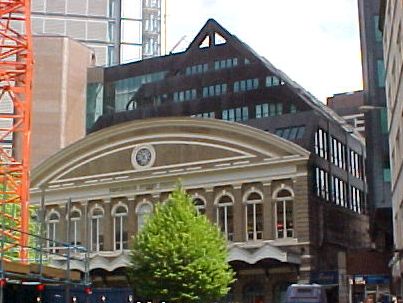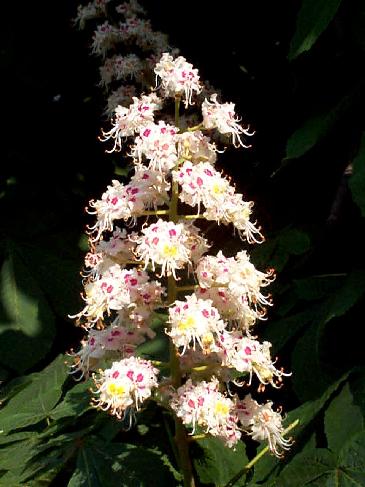The Wayward Isles | Site Index | John Cowper Powys | Home | Memoirs | Letters & Journals | Miscellaneous Pieces
Poetry Discovered

Cloistered all day in the office, I had forgotten once again
that an outside world existed. In a windowless office I saw no seasons, no day, no night.
There was only harsh lighting, never switched off. The shock of emerging into the
open air hit me afresh every evening. The street was like a canyon, with a river of people
streaming towards Bank Station.

I had to fight against the current of tributaries
converging on Fenchurch Street Station. Though more famous as a square on the Monopoly
board, this was where I worked, at least in the building constructed over its platforms.
Stretched above the seething canyon was an improbable indigo canopy. Its colour and the
intensity of its ultra-violet rays, even in this hour after sunset, bathed me in a glow as
if to say “Welcome back to the real created world”. Even here in this place
devoted to Mammon was the darkening winter sky, the same which loomed above ploughed
fields, Chiltern villages, the prehistoric Ridgeway path. Starlings, even, chattered
amongst the trees of Railway Place here in the City of London. I flowed with the human
river along Fenchurch Street and across Gracechurch Street. Here was the massive wall, of
granite ashlars, bearing Barclays carved spread-eagle and housing the Bank’s head
office1.

As I hurried past, adjusting my pace and path precisely to that of the
throng, to avoid jostling, I glanced at something scribbled in chalk, half rubbed off. The
words SPOKEN
BEAUTY were
written there. Who had written these words which suddenly echoed my unspoken thoughts?
When I looked more closely there was only an indistinct scrawl, some trivial graffiti, I
don’t even remember what it said. A poet had perhaps left a
message for the contemplation of a discerning few who hurried past this spot. The message,
once conveyed, had vanished.
Science and technology have neither theory nor patience to spare
for evanescent phenomena. They wrap the garbage tidily in a suitable name, such as illusion
or coincidence, and dispose it out of sight. The rules of their game insist on
it. So I can play my game, with my rules. These say that events which are unexplained,
unrepeatable and subjectively perceived to boot, are precious to me, when I say they are.
I think that’s about 50% of what poetry is. The other 50% is being able to share
that.
Thanks to a habit of scribbling notes on the Tube, I can relate
my first reactions and circumvent the possible distortions of memory. This is how I
recorded the happening a few minutes after:
“I
thought for a moment the scribble said SPOKEN BEAUTY. And then in a flash
came this image of something written but so beautiful & it existed as a
precious manuscript, never copied. Maybe not an illuminated manuscript, but done on
parch-ment and with full appreciation for the special nature of both content and
presentation.
“And the subject matter? The
experience of a joy. Co-existing in this world with the common routine and the mass of
people ... And in that moment I almost felt, in a flash, a very definition
of beauty.”
I went on to write of some special
characteristic which I felt to exist in my fellow passengers on the Tube—proof if it
were needed that on this occasion something fairly rare was happening, whether within me
or externally is not my affair to distinguish. That’s the beauty of making your own
rules with no allegiance to scientific orthodoxy. And a couple of weeks later (for the
dates are recorded as well) I wrote:
“Three
in the afternoon on the last day in January... there’s a light drizzle falling in
Fenchurch Street ... a blessed time and a blessed place to be. A billboard proclaims a
record pools win2 I’m glad it’s for someone else: if for me, my joy
in the shiny pavements, my joy without reason, could be disturbed.”
On this occasion, I recorded “just” a feeling—no suggestion
of magic occurring in the “outside” world. And it might have been forgotten
entirely, for I seldom used to re-read these notebooks, which in any event were scarcely
legible, due to the motion of the train and a cramped position (sometimes standing crushed
against other passengers with scarce room to hold a notebook open). But I happened to go
through the notebook yesterday and a few words descriptive of yet another experience leapt
from the page.
The event
took place at lunchtime where humanity flows more in eddies and backwaters, in search of a
sandwich or a pint of English beer. The back entrance to my office gave on to a street
named Crutched Friars. This has cobblestones and passes under a railway arch, which has
the Cheshire Cheese pub embedded in its vaulted wall. Opposite this pub, there was
a low flat roof attached to the railway bridge, just by the little street called Savage
Gardens. A few weeds grew on this roof languishing so desolate and unprofitable that you
knew that the place was simply biding its time for some major redevelopment. Some fragment
of soul seemed to tangle in this spot, like an evoked memory of childhood. Just as if they
had been written on a wall in chalk, the words LIFE IS NOT
IMPAIRED were presented to some inner
sense. My notebook of that day remarks merely:
“Breakthrough
to another world. The spot on Crutched Friars: LIFE IS NOT IMPAIRED. The
flash of intuition that went with it.”
Impairment can attack any body, any faculties. We insure against it but it
comes anyway. Death is final, irrevocable and total impairment. It strikes in all the
realms that we perceive: financial institutions, Mother Nature, every human existence.
Health and wholeness is a temporary flowering in every lifecycle. But, said this inner
voice, Life (itself) is not impaired.
It
was certainly on that occasion that I wondered, if not for the first time, about
“sacred places”. Incidents since then have encouraged me to attempt a
definition. A place is sacred when it acquires associations, for no discernible reason at
all, which then intensify in memory or on revisit: and these associations are such as to
enrich the soul. When expressed this way it’s not so weird, for we can trace it
through diverse cultures. The Zen poet Bashô wandered about Japan in the seventeenth
century visiting shrines and composing haikus of seventeen syllables to record “the
floating world”4. Their appeal can be more easily shared than explained:
“With a bit of madness in me,
Which is poetry,
I plod along like Chikusai
Among the wails of the wind.”
Whether the things I bring are worth sharing, I cannot tell. Each of us has our own
discoveries to make. Isn’t this the only learning, the only true experience?
Certainly that’s what Rousseau says in Émile. Maybe a true tale can be told
to move another soul. But what you find is unique and for you, whether shared or
not. Do our finds originate from the world or ourselves?
Each weekday
I migrate back to the labyrinths of the man-made data-world, the schemas, the logic paths,
the mad towers of Babel. But when May comes round I recall a time in Brent Lodge Park,
Hanwell, in sight of the great viaduct, where I first discovered horse-chestnut blossom.
If you have never examined these flowers closely, be ready for a surprise when you do!
They speak their own unreasonable beauty, and freshly confirm that life is not impaired5.

The Internet is no substitute for
observing Nature directly. But on this photo you can just see something extraordinary
about these blossoms.
1Since
pulled down and replaced by a new Head Office. Incidentally, I am struck by the parallel
between the scrawl I saw on Barclays Bank wall and the sign displayed to Harry
Haller in Herman Hesse’s novel Steppenwolf: “Why have his
letters been playing on this old wall . . . why were they so fleeting, so fitful and so
illegible? But wait, at last I succeeded in catching several words on end. They were: MAGIC
THEATRE: ENTRANCE NOT FOR EVERYBODY . . . FOR MADMEN ONLY!
2Before
the National Lottery, people fulled their dreams with a bet on the Football Pools. Their
chances were tiny but considerable publicity was given to the big winners.
3See Basho’s The Narrow Road to the Deep North (Penguin Classics).
4Chikusai
is “the hero of a comic story ... a quack more experienced in provoking laughter than
in medicine”. (op.cit.)
Postscripts
I later found that the life-affirming
qualities of chestnut blossoms had spoken also to others. This comes from The Grace of
Great Things: Creativity and Imagination by Robert Grudin:
As a young man, the psychiatrist Viktor Frankl was deported to
Auschwitz. His medical background made him useful to the authorities, who employed him to
attend the sick and dying. Among the many stories he tells of those times is one that
serves for him as a special example of “inner greatness.” It concerns someone
who was fatally ill. He relates:
This young woman knew that she would die
in the next few days. But when I talked to her she was cheerful in spite of this
knowledge. “I am grateful that fate has hit me so hard,” she told me. “In
my former life I was spoiled and did not take spiritual accomplishments seriously.”
Pointing through the window of the hut, she said, “This tree here is the only friend
I have in my loneliness.” Through that window she could see just one branch of a
chestnut tree, and on the branch were two blossoms. “I often talk to this tree,”
she said to me. I was startled and didn’t quite know how to take her words. Was she
delirious? Did she have occasional hallucinations? Anxiously I asked her if the tree
replied. “Yes.” What did it say to her? She answered, “It said to me,
‘I am here - I am here - I am life, eternal life.’”
On 7th May 2006, in the time of chestnut blossom in Buckinghamshire, my thoughts again turned to this wonderful phenomenon of nature, and discovered that Anne Frank had been succoured by it, when she was stuck in her secret annex, and “her” tree is now revered in its own right, with its own dedicated webcam, and experts struggling to save its life or take grafts to ensure its renaissance if they fail.
On May 13, 1944 Anne wrote in her diary: ‘Our chestnut tree is in full bloom. It’s covered with leaves and is even more beautiful than last year.’
See the Anne Frank Tree website.
On the inspirational qualities of chalked inscriptions, a reader from
Australia sent in the following:
Your
story reminded me of a man in Sydney, long gone. In the last years of his life, he
dedicated himself to chalking an inscription on pavements all over Sydney. A poor man,
almost illiterate, he managed to write in a perfect copperplate script the one word “Eternity”.
In this single word he intended to proclaim God’s glory, and to remind all who
saw it that life holds a greater secret than normally meets the eye. It seems that
people were indeed reminded! They recall him with affection and reverence as if he were a
great man and on 1st January 2000, as part of Sydney's Millennium celebrations the word
was proudly hung from the Sydney Harbour Bridge. [It remained there to celebrate the
closing of the Olympic Games in the same year.]

For
more background on the “Eternity man”, try these links:
3See Basho’s The Narrow Road to the Deep North (Penguin Classics).
4Chikusai is “the hero of a comic story ... a quack more experienced in provoking laughter than in medicine”. (op.cit.)
Postscripts
I later found that the life-affirming qualities of chestnut blossoms had spoken also to others. This comes from The Grace of Great Things: Creativity and Imagination by Robert Grudin:
As a young man, the psychiatrist Viktor Frankl was deported to Auschwitz. His medical background made him useful to the authorities, who employed him to attend the sick and dying. Among the many stories he tells of those times is one that serves for him as a special example of “inner greatness.” It concerns someone who was fatally ill. He relates:
This young woman knew that she would die in the next few days. But when I talked to her she was cheerful in spite of this knowledge. “I am grateful that fate has hit me so hard,” she told me. “In my former life I was spoiled and did not take spiritual accomplishments seriously.” Pointing through the window of the hut, she said, “This tree here is the only friend I have in my loneliness.” Through that window she could see just one branch of a chestnut tree, and on the branch were two blossoms. “I often talk to this tree,” she said to me. I was startled and didn’t quite know how to take her words. Was she delirious? Did she have occasional hallucinations? Anxiously I asked her if the tree replied. “Yes.” What did it say to her? She answered, “It said to me, ‘I am here - I am here - I am life, eternal life.’”
On 7th May 2006, in the time of chestnut blossom in Buckinghamshire, my thoughts again turned to this wonderful phenomenon of nature, and discovered that Anne Frank had been succoured by it, when she was stuck in her secret annex, and “her” tree is now revered in its own right, with its own dedicated webcam, and experts struggling to save its life or take grafts to ensure its renaissance if they fail.
On May 13, 1944 Anne wrote in her diary: ‘Our chestnut tree is in full bloom. It’s covered with leaves and is even more beautiful than last year.’
See the Anne Frank Tree website.
On the inspirational qualities of chalked inscriptions, a reader from Australia sent in the following:
Your story reminded me of a man in Sydney, long gone. In the last years of his life, he dedicated himself to chalking an inscription on pavements all over Sydney. A poor man, almost illiterate, he managed to write in a perfect copperplate script the one word “Eternity”. In this single word he intended to proclaim God’s glory, and to remind all who saw it that life holds a greater secret than normally meets the eye. It seems that people were indeed reminded! They recall him with affection and reverence as if he were a great man and on 1st January 2000, as part of Sydney's Millennium celebrations the word was proudly hung from the Sydney Harbour Bridge. [It remained there to celebrate the closing of the Olympic Games in the same year.]

For
more background on the “Eternity man”, try these links: